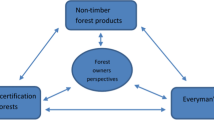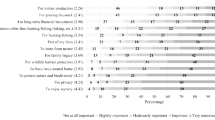Abstract
Production of non-timber forest products (NTFPs) offers a way for landowners to generate income without harvesting timber. In Alabama, pine straw is a NTFP with strong market potential, but the market is relatively undeveloped compared to markets in some other Southeastern states. A mail survey was conducted to assess the willingness of landowners to engage in alternative forestry enterprises, including pine straw harvesting. Those who owned a relatively large forest area (especially of planted pine), had used a consulting forester, and lived outside of the county where their forestland was located had higher levels of interest in harvesting pine straw for profit. Landowners who resided in the same county as their forestland expected higher prices for their pine straw than absentee owners. Primary concerns among landowners interested in harvesting pine straw were related to lack of technical information and lack of a product market.
Similar content being viewed by others
References
Alabama Forestry Commission (2013) Alabama forest facts. http://www.forestry.state.al.us/forest_facts.aspx. Accessed May 2013
Arano KG, Munn IA (2006) Evaluating forest management intensity: a comparison among major forest landowner types. For Policy Econ 9(3):237–248
Boatright SR and JC McKissick (2010) 2009 Georgia farm gate value report. The University of Georgia: Center for Agribusiness and Economic Development. http://www.caed.uga.edu/publications/2010/pdf/AR-10-01.pdf .Accessed Sept 2010
CasanovaV (2007) Three essays on the pine straw industry in a Georgia community. Ph.D dissertation in Forestry, School of Forestry and Wildlife Sciences, Auburn University
Chamberlain JL, Mitchell D, Brigham T, Hobby T, Zabek L, Davis J (2009) Forest farming practices. In: Garrett HE (ed) North American agroforestry: an integrated science and practice, 2nd edn. American Society of Agronomy Inc, Madison, pp 219–255
DeCoster LA (2000) Summary of the forest fragmentation 2000 conference: How forests are being nibbled to death by DUCs, and what to do about it. In: DeCoster LA (ed) Proceedings of the forest fragmentation 2000 conference (11 p). http://www.sampsongroup.com/acrobat/fragsum.pdf. Accessed 5 Nov 2010
Dickens ED, Moorhead DJ, Bargeron CT, Morris LA, Ogden LA, McElvany BC (2012) A summary of pine straw yields and economic benefits in loblolly, longleaf, and slash pine stands. Agrofor Syst 86(3):315–321
Dillman DA (2000) Mail and internet surveys: the tailored design method, 2nd edn. Wiley, New York
Doherty BA, Dykes N and McKissick JC (2001) 2000 Georgia Farmgate Value Report. The University of Georgia: Center for Agribusiness & Economic Development. http://www.agecon.uga.edu/~caed/00farmval. Accessed Jan 2011
Dyer JF, Barlow R, Keever GJ, Morse W (2012) Market demands and characteristic preferences for pine straw in Alabama. J Environ Hortic 30(1):1–7
Gholz HL, Perry CS, Cropper WP Jr, Hendry LC (1985) Litterfall, decomposition, and nitrogen and phosphorus dynamics in a chronosequence of slash pine (Pinus elliotii) plantations. For Sci 31(2):463–478
Haywood JD (2009) Influence of pine straw harvesting, prescribed fire, and fertilization on a Louisiana longleaf pine site. South J Appl For 33(3):115–120
Haywood JD, Tiarks AE, Elliott-Smith ML, Pearson HA (1998) Response of direct seeded Pinus palustris and herbaceous vegetation to fertilization, burning, and pine straw harvesting. Biomass Bioenerg 14(2):157–167
Hodges AW, Mulkey WD , Alavalapati JR, Carter DR and Kiker CF (2005) Economic impacts of the forest industry in Florida, 2003. University of Florida, Institute of Food & Agricultural Sciences. Publication #FE538. Final Report to the Florida Forestry Association
Kelly LA, Wentworth TR, Brownie C (2002) Scaling species dynamics in Pinus palustris communities: effects of pine straw raking. J Veg Sci 13(6):755–764
Lopez-Zamora I, Duryea ML, McCormac-Wild C, Comerford NB, Neary DG (2001) Effect of pine needle removal and fertilization on tree growth and soil P availability in a Pinus elliottii Engelm. var. elliottii stand. For Ecol Manage 148:125–134
Mills R and Robertson DR (1991) Production and marketing of Louisiana pine straw. Louisiana cooperative extension service publication 2430. Baton Rouge, Louisiana State University. http://www.lsuagcenter.com/NR/rdonlyres/15AEA06F-DEEF-46F2-A50E−27C93484769A/11003/ProductionandMarketingofLouisianaPineStraw_2430.pdf. Accessed Apr 2012
Minogue PJ, Ober HK, Rosenthal S (2007) Overview of pine straw production in north Florida: Potential revenues, fertilization practices, and vegetation management recommendations. Florida cooperative extension service, IFAS, University of Florida, Publication FOR125, Charlotte
Pote DH, Grigg BC, Blanche CA, Daniel TC (2004) Effects of pine straw harvesting on quantity and quality of surface runoff. J Soil Water Conserv 59(5):197–204
Rowland G (2003) Pine straw market. North Central Mississippi RC&D council. http://www.naturalresources.msstate.edu/pdfs/pinestraw.pdf. Accessed Apr 2012
SPSS Inc. (2009). PASW statistics for windows, version 18.0. SPSS Inc, Chicago
Taylor EL, Foster CD (2004) Producing pine straw in East Texas forests. Texas cooperative extension publication B-6145, Gonzales
Wear DN and Greis JG (2002) Southern forest resource assessment: summary report. General Technical Report SRS-54. Asheville, NC: U.S. Department of Agriculture, Forest Service, Southern Research Station, 103 p
Workman SW, Bannister ME, Nair PKR (2003) Agroforestry potential in the Southeastern United States: perceptions of landowners and extension professionals. Agrofor Syst 59:73–83
Zhou N (2010) An econometric analysis of Alabama rural land values. M.S. Thesis in the School of Forestry and Wildlife Sciences, Auburn University
Author information
Authors and Affiliations
Corresponding author
Rights and permissions
About this article
Cite this article
Dyer, J.F., Barlow, B., Kush, J. et al. Factors affecting Alabama landowner interest in harvesting pine straw and willingness to accept prices. Agroforest Syst 89, 829–839 (2015). https://doi.org/10.1007/s10457-015-9816-8
Received:
Accepted:
Published:
Issue Date:
DOI: https://doi.org/10.1007/s10457-015-9816-8




